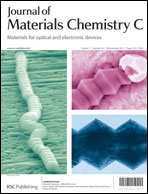Tuning the electrical memory characteristics from WORM to flash by α- and β-substitution of the electron-donating naphthylamine moieties in functional polyimides†
Abstract
Two novel functional aromatic polyimides (PIs), 6F-αNA PI and 6F-βNA PI, in which the hexafluoroisopropylidene-diphthalic anhydride (6FDA) serves as the electron-accepting unit and the diphenylnaphthylamine (DPNA) functions as the electron-donating species, were synthesized for memory device applications. The 6F-αNA PI shows distinct electrical bistable states with an ON/OFF current ratio up to 106, and can be switched on bi-directionally with no polarity, which could be applied as the nonvolatile write-once read-many times (WORM) memory. Whereas, the 6F-βNA PI-based memory device exhibits flash type memory characteristics with a switching-on voltage at ca. 1.1 V and an ON/OFF ratio of 104. Both polyimides exhibit good long-term operation stability, survive up to 108 reading cycles with no current degradation, and show ultrafast switching with a response time less than 20 ns. Mechanisms associated with the electrical switching behaviors are discussed on the basis of the experimental and quantum simulation results. The electric-field-induced electronic transition from diphenylnaphthylamine units to hexafluoropropylidene phthalimide units and the subsequent formation of charge-transfer complexes are supposed to be responsible for the observed electrical memory effects. Molecular simulation suggests that α-tethering of the naphthyl group results in more non-coplanar conformation of the DPNA species in the 6F-αNA PI, as compared to that of the β-tethering in the 6F-βNA PI, therefore producing a higher energy barrier that prevents the back charge transfer processes, consequently leading to the WORM vs. flash memory behaviors. The 6F-αNA PI differs from 6F-βNA PI only in the substitution position of the naphthyl group, i.e., α-tethering vs. β-tethering. The distinct memory effects observed here suggest the significance of the electron-donating structures on the memory effects, and the tailorability of the memory characteristics through fine structure adjustment.


 Please wait while we load your content...
Please wait while we load your content...